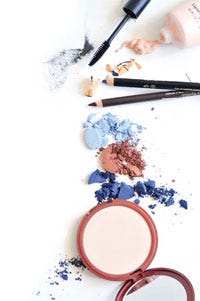How to choose nontoxic makeup
Lipstick, eye makeup, powder, and other cosmetics can contain potentially toxic ingredients. How can you know which ingredients to avoid, and how to choose the best options? Check out our simple guide to finding nontoxic makeup. Plus, top product picks.
April 28, 2011

It took years to find makeup products that help you look and feel your best. But many of the staples you trust for their beauty benefits are harboring ugly ingredients with potential health risks—think petroleum byproducts, chemical preservatives, and synthetic colors and fragrances. Because women apply an average of 12 beauty products each day, cumulative exposure to toxins can be a serious concern. “There are tons of wonderful nontoxic products on the market; it's just about finding the product that works best for you,” says Los Angeles–based celebrity makeup artist and natural-beauty expert Lina Hanson, author of Eco-Beautiful (Rodale, 2009). Use this guide pinpointing the worst offenders—and safe, effective alternatives—to jump-start your makeup overhaul.
staples you trust for their beauty benefits are harboring ugly ingredients with potential health risks—think petroleum byproducts, chemical preservatives, and synthetic colors and fragrances. Because women apply an average of 12 beauty products each day, cumulative exposure to toxins can be a serious concern. “There are tons of wonderful nontoxic products on the market; it's just about finding the product that works best for you,” says Los Angeles–based celebrity makeup artist and natural-beauty expert Lina Hanson, author of Eco-Beautiful (Rodale, 2009). Use this guide pinpointing the worst offenders—and safe, effective alternatives—to jump-start your makeup overhaul.
Foundation
Foundation is a flawless-skin essential, but most conventional formulas contain paraben preservatives, which are known hormone disruptors that mimic estrogen. Also avoid synthetic fragrance, commonly added to foundation and other conventional makeup. “Fragrance can be quite a cocktail of chemicals that are either toxic or have never been tested for safety. There can be hundreds of chemical ingredients in one fragrance,” says Mia Davis, organizing director of The Campaign for Safe Cosmetics. Hanson recommends switching to paraben-free, fragrance-free concealer and foundation that use minerals for color and natural emollients (such as coconut oil) for texture. Look for a titanium-dioxide or zinc-oxide mineral base on labels. A few innovative natural companies are also creating color products that use fruit, vegetable, and flower pigments.
Try: ZuZu Luxe Oil-Free Liquid Foundation, RMS Beauty “Un” Cover-Up
Eye shadow, eyeliner, and mascara
To define eyes, eye shadow, eyeliner, and mascara are an indispensable trio. But conventional versions often contain aluminum powder, a color additive that the Environmental Working Group links to human neurotoxicity and cancer. Eye shadow and mascara particles easily fall into the eyes, and the thin eyelid skin is among the most sensitive on the body. To avoid exposure, Hanson lines lids with“smudge-proof” eyeliner that contains mineral color and emollients like castor oil, jojoba oil, and vitamin E, as well as a creamy mineral-pigment “eye gloss.” She also recommends mascara with fortifying ingredients like vitamin B5, for “full, strong lashes.”
Try: Gabriel Cosmetics Eye Liner, Jane Iredale Eye Gloss, Nvey Eco Organic Mascara
Lipstick
One coat of lipstick can make a bare face look polished, but think twice before your next swipe. Lipstick, which you ingest in small amounts with every wear, often contains synthetic fragrance and color and paraben preservatives, which can accumulate over a lifetime. The Campaign for Safe Cosmetics and the FDA also link many conventional lipsticks to lead contamination. “Lead is a potent neurotoxin that builds up in our bodies. Lead in lipstick is just unacceptable,” says Davis. Look for lipstick withmoisturizing and nourishing beeswax, jojoba oil, and vitamin E that are colored with plant or mineral pigments like iron oxide or mica, for shimmer, says Hanson.
Try: Afterglow Cosmetics Organic Lip Love Lipstick, Hemp Organics Lipstick
Powder
A veil of powder may be the perfect finish to your look, but many conventional versions are packed with talc, a filler containing potentially toxic and carcinogenic ingredients that also carries asbestos-contamination risks. “We found that many companies have done their due diligence to avoid asbestos contamination. But we don’t feel comfortable saying that it’s no longer a concern,” says Davis, who adds that health risks increase because powder is commonly inhaled during application. Hanson recommends natural powders with oil-absorbing rice starch, cornstarch, or kaolin clay to control shine. “Also look for a powder with flower waxes and extracts, which benefit the skin over time by promoting a youthful complexion and improving elasticity with antioxidants,” says Hanson.
Try: Mineral Fusion Setting Powder, Ecco Bella FlowerColor Face Powder
Cosmetics Legislation: Safe Cosmetics Act of 2010
On July 21, 2010, the Safe Cosmetics Act was first introduced in the U.S. House of Representatives. The bill, which aims to regulate cosmetics’ manufacturing and labeling, will be reintroduced in the House and introduced in the Senate this spring. To learn more about this legislation and find out how you can contact your elected officials in support of the bill, visit safecosmetics.org. “It’s important for consumers to vote with their dollars and to support companies that are trying to produce safer products, but we need to change the system that allows chemicals into the market in the first place,” says Mia Davis, organizing director of The Campaign for Safe Cosmetics. “We need to remember that this bill will impact our lives on a daily basis because we use these products every day.”
You May Also Like


